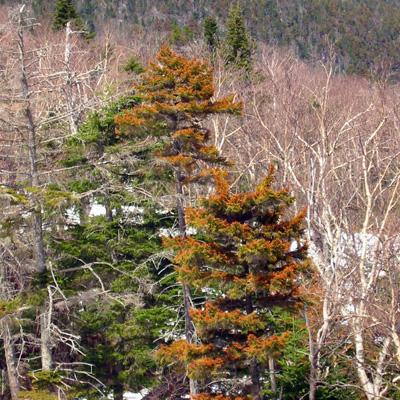A Quantitative Assessment of the Influence of Winter Injury and Calcium Depletion on the Productivity of Red Spruce Trees in the Northern Forest

Red spruce winter injury, the reddening and mortality of foliage in late winter following freezing damage, can lead to tree health declines and eventual mortality. Although it is now clear that altered calcium nutrition helps predispose red spruce to winter injury, altered nutrition is not a complete explanation for the year-to-year variation in severity of winter injury across the Northern Forest region. NSRC researchers determined what weather-related factors contribute to spruce winter injury and how much this injury influences tree carbon stores.
Researchers used a long-term record of red spruce winter injury in a New Hampshire plantation and conducted analyses with local weather data to determine which environmental factors helped account for injury. Elevated winter injury was consistently associated with low-temperature stresses and factors, such as mid-winter thaws or shortened growing seasons, which predisposed trees to injury. At this plantation, there was a significant relationship between winter injury and growth reductions for two years after a severe winter injury event. Analyses of data from 23 plots in Vermont, New Hampshire, and Massachusetts indicated a similar regional response.
Researchers estimated a conservative reduction of 394,000 metric tons of carbon sequestered in living red spruce stems greater than 20 centimeters in diameter growing in New York and northern New England during the two years following a severe winter injury event. Climate change is predicted to increase the nature and extent of weather extremes associated with increases in winter injury, and reductions in carbon sequestration and increases in carbon dioxide that follow spruce winter injury, decline, and mortality may further propel climate change.
